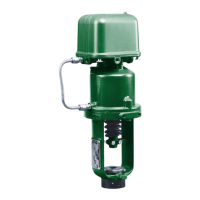Instruction Manual
D200137X012
3570 Positioners
September 2015
11
figure 10). The maximum allowable input signal for positioners with standard or optional bellows is in table 1 (bellows
pressure rating). The instrument connection is made at the factory when a complete control valve assembly with a
valve‐mounted control device is ordered. Otherwise, make field connections to the positioner from an appropriate
control device. Refer to table 1 and the nameplate for input signal pressure ranges.
Operating Information
Initial Adjustments
Normally, no adjustments are necessary upon initial installation. The positioner is set at the factory for the travel, input
signal range, and action specified in the order. Adjustment is necessary when operating conditions are changed, when
the unit has been dismantled and reassembled, or when the control valve travel does not correspond to the desired
input signal range. If the operating conditions have not changed but the positioner requires adjustment, refer to the
adjustment procedures in this section. If the operating conditions have changed a new range spring, bias spring, and
springer retainer/spacer may be required. Contact your Emerson Process Management sales office
for assistance in
determining if a new range spring, bias spring, and spring retainer/spacer are required. Refer to the Range Spring, Bias
Spring, and Spring Retainer/Spacer Selection for 3570 Pneumatic Valve Positioners Instruction Manual Supplement
(D104021X012).
Adjustment Procedures
Refer to figure 2. 3570 positioners have three adjustments:
D The bias spring. It is the zero adjustment which determines the starting point of the valve plug travel.
D The range spring. It is the span adjustment which determines the full valve plug travel for a given input signal range.
D The relay nozzle adjustment. This adjustment determines the steady‐state positioner output pressure.
To illustrate the use of the various adjustments, assume that the positioner has been repaired or has become
completely out of adjustment. Assume also that the input signal range is 0.2 to 1 bar (3 to 15 psig). Proceed as follows:
1. Make sure the input signal range and the valve travel stamped on the nameplate agree with the present operating
conditions.
2. Loosen the four thumb screws on the underside of the positioner base and remove the cover.
3. Provide a means for varying the input signal pressure from zero to 0.07 or 0.14 bar (1 or 2 psig) above the higher
value of the input signal range (see table 1). Provide an accurate means of measuring the input signal pressure.
Check the accuracy of the positioner instrument pressure gauge (see figure 4). The gauge accuracy is ±0.04 bar
(±0.6 psig) on a 0 to 2 bar (0 to 30 psig) gauge, and ±0.08 bar (±1.2 psig) on a 0 to 2 bar (0 to 60 psig) gauge. This
accuracy is measured at the mid‐point of the full range of the scale.
4. Set the input signal pressure at the mid‐point of its range [0.6 bar (9 psig) in this example]. Observe the valve travel
indicator scale attached to the yoke. The indicator disk should be somewhere between the open and closed
positions.
5. Loosen the locknut directly below the bias spring seat (see figure 2) and adjust the bias spring up or down until the
valve travel indicator disk shows that the valve plug is somewhere between the open and closed positions. Upward
movement of the bias spring adjustment causes downward travel of the valve stem.

